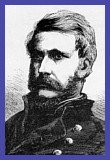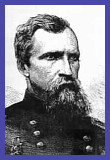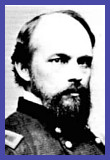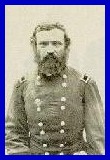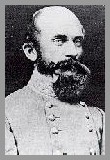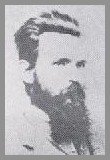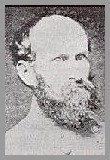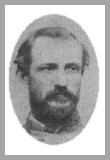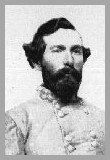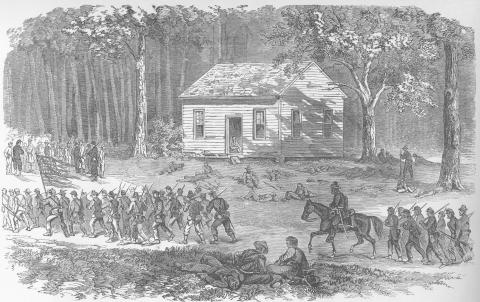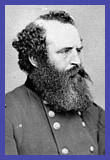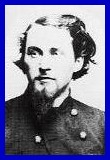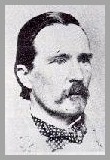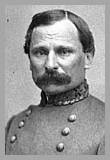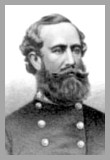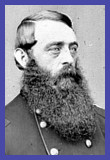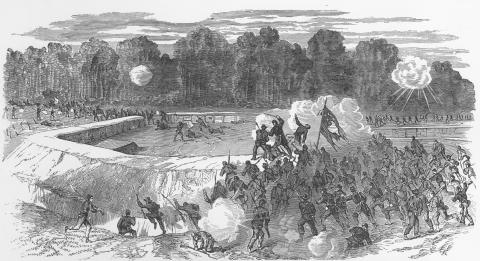Overview Following the successful lodgement on the Weldon Railroad in late August, Grant had the armies besieging Petersburg lie quiet and rest. In late September, however, another double-ended expedition was planned and executed. The Richmond end of the operation had an unlikely genesis. Ben Butler, commanding officer of the Army of the James, was of the opinion that a lodgement could be made in the outer line of Confederate works protecting Richmond. If successful, such a breakthrough would threaten the important fort at Chaffin's Bluff, which was vital to keeping the James River closed as an effective avenue of attack on Richmond. Butler's optimism was based on a careful analysis of Confederate strengths, which led him to believe (correctly) that the garrison north of the James was very weak. On the Petersburg side, it was simply time to make another effort at completing the investment of the city by striking out for the Southside Railroad and the Appomattox River, west of Petersburg. Accordingly, troops would be detailed to conduct a reconnaissance in force along the Federal left, hoping to exploit any weaknesses caused by detachments to face Butler. The present terminus of the Union lines, at Globe Tavern, was less than six miles from the railroad and slightly more than seven from the river. The immediate target of the Richmond side of the operation would be Fort Harrison, an enclosed and fortified camp on the outer Confederate works southeast of Richmond, along the Varina Road, about a mile or so from Chaffin's Bluff. The troops involved would be the XVIII Corps, under Maj. Gen. E.O.C. Ord, supported by the men of the X Corps under Maj. Gen. David Bell Birney. As in the two previous operations on the Richmond front, Federal cavalry would attempt to reach the Virginia Central Railroad. On the South Side, the Federal troops would be V Corps and IX Corps, with some support available from II Corps. |
|
||||||||||||
Fort Harrison and New Market Heights (Sept. 28-30) There were three lines of entrenchments protecting the southeastern approaches to Richmond, and a fourth set along New Market Heights, disputing the passage out of the Deep Bottom lodgement. Butler's plan was to send one column along the Varina Road and straight at the outer line of works, at a redoubt known as Fort Harrison. The second, supporting, column would attack the unfinished line near Deep Bottom, then turn westward to join the attack on Richmond. The main column would be led by Ord and would consist of 8,000 from his XVIII Corps. Birney, with 10,000 men from X Corps, would attack the New Market Heights line. If Butler's information was correct, the Confederates had only three infantry and one cavalry brigades to supplement the garrison troops and artillery in the forts. On the night of September 28th, Ord's column crossed the James on a new pontoon bridge at Aitken's Landing, some distance to the west of Deep Bottom, where Birney crossed. (See map for an overview of the terrain.) Birney's column would consist entirely of United States Colored Troop regiments. Butler's information was indeed correct. The Confederate defenses in the immediate area consisted of three infantry brigades and one cavalry brigade, together with garrison troops and heavy artillery manning the actual Richmond defenses. Overall command north of the James was jointly exercised by Lt. Gen. Richard S. Ewell, who had formerly commanded Lee's Second Corps and now commanded the Department of Richmond; and Brig. Gen. John Gregg of the Texas Brigade, senior officer of the Army of Northern Virginia north of the James. Unbeknownst to the Federals, their attack caught the Confederates with an awkward command situation, in the middle of a transition. Ewell's command consisted of the garrison infantry and artillery, together with Bushrod Johnson's former Tennessee brigade, now under Col. John M. Hughs of the 25th Tennessee. Gregg commanded his own Texas Brigade, under Lt. Col. Frederick Bass of the 1st Texas, Benning's Georgia Brigade, under Col. Dudley DuBose of the 15th Georgia, and the South Carolina cavalry brigade of Brig. Gen. Martin Gary, together with about 16 artillery pieces from Lee's Army and a couple of battalions from Ewell's department that had been assigned to him. Lee had determined to end this divided command by recalling Lt. Gen. Richard H. Anderson from the Shenandoah Valley, in order to place him in overall command north of the James, but Anderson did not arrive until nearly noon on September 28th -- after the situation had become critical. Confederate outposts had detected the two Federal columns soon after they crossed the river, and the alarm went out all along the Confederate lines. From Petersburg, Lee ordered three brigades of Maj. Gen. Charles Field's division to march at once for the north side of the James. Gregg concentrated his troops along New Market Heights, confronting Birney's X Corps column. Ewell concentrated most of his troops in the entrenched lines nearest the river. The Tennessee brigade of Hughs was left to hold back XVIII Corps along the Varina Road. Birney made contact with the Confederate lines along New Market Heights at about 5:30 in the morning. This line of works was roughly L-shaped, the main line running east-west parallel to the New Market Road, with the left flank refused along Bailey's Run to the east. In July and August, Hancock had maneuvered to the right to attack this line from the east along the New Market Road. Birney elected to attack directly up the Heights from Deep Bottom. Although defended by only about 1,800 graycoats, the line was strong enough to hold off Birney's initial attacks; the fact that Birney was only able to get single brigades in action at a time did not hinder the defense. However, events over at Fort Harrison caused the entire Confederate defense force to be withdrawn from New Market Heights so Birney soon was able to break through and seize the line that had baffled Hancock twice before. Ord's column made contact with the Rebels at about the same time as Birney. The Tennesseans were not able to impose much of a delay on the Federals; it was shortly before 6:00 a.m. that Ord's column began to deploy in front of the Rebel Exterior Line. After a short pause, Ord was convinced by his lead division commander, Brig. Gen. George Stannard (whose Vermont brigade had played a leading role in repulsing Pickett's Charge at Gettysburg) to allow an assault on Fort Harrison. Ord had wanted to mask Fort Harrison and attack elsewhere, but Stannard saw it as the key to the Rebel position. Although strongly entrenched on a small hill, and equipped with heavy artillery, the fort was only manned by 800 troops, mostly from Hughs's brigade, and a single regiment from DuBose's brigade that had not yet moved out for the New Market line. By now the Confederates were fully aware that the main threat was not at New Market Heights, and Gregg issued orders to abandon that position in order to reinforce Fort Harrison, but it was too late for that. At about 6:00 a.m. Stannard's division moved out and assaulted the fort with great gallantry, suffering heavily before closing with the Rebels. By 7:00 a.m. Fort Harrison had been carried and the outer line protecting Richmond had been breached. The New Market line had been abandoned in order to bolster the main line, but the troops had not arrived in time to stop Ord's attack. The day was young, the prospects --- for the Federals --- bright. These bright prospects would eventually be dimmed by the inevitable disorganization that followed nearly every successful attack in the war. Stannard, together with all four of his brigade commanders had been wounded in the attack, and Ord's reserve division, under Charles Heckman, while attacking to the right of Stannard and carrying that portion of the works, was unavailable to exploit Stannard's success. Ord managed to organize a small force of men, with which he attempted to sweep southward along the outer line towards the river. Initially successful, this effort was soon stymied by stiff Rebel resistance and the sporadic shelling from the Confederate James River fleet, whose large calibre guns made up in noise and terror what they lacked in accuracy and actual effect. Meanwhile, Dick Ewell was displaying the kind of battlefield leadership that had earned him his earlier reputation --- in fact, at least one historian has suggested that Ewell's successful efforts to prevent Ord from driving south from Fort Harrison into the rear of the James River forts may have been his best day's work for the Confederate cause. At about this time Ord --- one of the most oft-wounded officers in the Federal army --- was hit in the leg and forced to relinquish command of his corps. The ranking division commander was Heckman, who after taking the works to the right of Harrison against almost token opposition, had then battered his men senselessly against the intermediate line to his front, instead of shifting left to take advantage of the opening at Fort Harrison. The Federal effort was beginning to bog down. Meanwhile, Kautz's cavalry division had broken out of the Deep Bottom bridgehead after the collapse of the New Market Heights line. They first attempted to advance down the Darbytown Road but were stopped by a scratch force of around 100 men at about 10 a.m., within two miles of the city itself. Under orders to flank resistence rather than overpower it, Kautz did not press forward. Shifting northward to the Charles City Road, Kautz tried again, and again was stopped, this time at about 1 p.m. Never exactly a daring officer to begin with, Kautz was now being thoroughly cautious. He spent the rest of the day cautiously shifting to the right and probing the Richmond lines. At midnight he was almost due north of the city but had accomplished very little indeed. The forces that he had been fighting had been almost exclusively the heavy artillery and Local Defense Force. Unable to remain in his exposed position, Kautz spent the night falling back to the main Federal position, arriving 7:30 a.m., on September 30. Eventually Birney's X Corps troops arrived at the Richmond works alongside Ord's men, this occuring prior to 9:00 a.m. The situation had stabilized somewhat, but the Rebels, even with Gregg's troops from the New Market Line on hand, by no means had a sufficient force. Birney decided to attack Fort Gilmer, slightly to the northeast of Fort Harrison and on the Intermediate Line. Gilmer was now the key to the Rebel position; if the Federals were able to take it, the forts to the south along the river would be untenable. Unfortunately for the Federals, the attack (made at about 1:30), did not have the success that Stannard's had, and Gilmer held. A second attack made at about 2:30 was even less successful. Supporting efforts by Heckman's XVIII Corps division might have been decisive, but that officer was unable to get his troops in motion in time to coordinate with Birney. By now the Confederates had been able to shift men from Petersburg to the Richmond front -- the first of Field's brigades (Law's Alabamians, under Col. P. D. Bowles) arrived near Fort Gilmer at about 2:30 p.m. -- and in fact the Federal position was in danger on its left flank. Birney was forced to pull back from his advanced position in front of Fort Gilmer in order to form a connected line with Ord's men at Fort Harrison. During the night the Federals turned the Rebel works around and extended their own left down to the river, taking up a line running roughly south-to-north along the course of the former Confederate Exterior Line. Having failed to fully exploit the potential of their early successes, the Yankees were now concerned primarily with holding on to their gains. On September 30th, Lee prepared a major effort to dislodge the Federals from Fort Harrison. The attack would be made under Richard Anderson's command, by Hoke's and Field's divisions, which would jointly assault the new Federal position. There would be about 9,000 Rebels to attack 2,000 Federals at the point of attack. Unfortunately for the Confederates they were unable to get their numerical advantage into play. As a preliminary move to the actual attack, G.T. Anderson's Georgia brigade was to move forward and occupy a depression close to the Federal lines. Here they would be protected from enemy fire, yet well-positioned to lunge forward when the rest of the force assaulted. However, Anderson lost control of his men; instead of moving into the depression and awaiting the rest of their comrades, the ill-fated Georgians simply continued on to attack the Yankees, who were easily able to repulse them with great loss. Meanwhile, Field's other two brigades had been advancing behind Anderson. Thrown into some disorder by the retreat of the Georgians, these men were unable to make a dent in the Federals. Not until Field was falling back did Hoke begin his attack; this, too, was repulsed easily. Instead of a concerted effort by eight of his brigades, Lee was forced to watch his men make three separate piecemeal attacks, with only five of the brigades getting into action before it was all called off. Lee had lost upwards of 1,200 men he could ill-afford to be without. The Confederate commander did not like it, but he would have to at least tolerate the Federal presence north of the James for a little longer. Events were in motion at Petersburg that required attention. This would end the action north of the James. Butler's plan, together with the decisiveness of Ord and Stannard, had given Grant a substantial victory, but the efforts of Ewell and Anderson, together with the timidity of several Federal officers, had kept the Federal success from being all that it might have been. Butler's troops had lost about 3,350 men, and Lee had lost approximately 1,700. |
|
||||||||||||
Peebles Farm (Sept. 30 - Oct. 2) With Lee clearly making a major effort to recover the ground lost north of the James, Grant decided to make an effort on the south side. Grant's motivation was partly to take advantage of any detachments Lee had made to deal with Butler, and partly to prevent any more such detachments. After the Federals had made their August lodgement on the Weldon Railroad, the Boydton Plank Road became the vital artery into Richmond, for it was along the Boydton that the wagon trains from Stony Creek Station on the Weldon Railroad entered Petersburg with supplies. Accordingly, Lee had begun to construct a line of entrenchments which angled out southwestward from the original Petersburg lines, covering the Boydton Road. This new line was anchored on its right at Hatcher's Run, and actually would extend farther south that the end of the Union lines at Globe Tavern. While this line was being constructed, a covering line had been partially built in front of it, near Peebles Farm, roughly along the colorfully named Squirrel Level Road. This would be the initial target of the Army of the Potomac. The Rebel lines were actually held by the most skeletal of forces. When Butler's columns appeared in front of Richmond, Lee had withdrawn the troops from both the Boydton Plank Road line and the Squirrel Level line, and replaced them with dismounted cavalry. The Confederate commander appears to have been of the opinion that it would be better to have a concentrated mobile reserve to attack any enemy columns, rather than expend the men in a passive defense of the lines. The troops, basically Heth's division of Hill's Corps, were assembled inside the main Petersburg works. (According to Richard Sommers, whose study of this portion of the Petersburg Campaign has been most useful to the writing of this article, it is possible that Lee actually contemplated evacuating Petersburg on the night of September 29, in reaction to the seizure of Fort Harrison, in order to better concentrate his men to recover Harrison, taking up a new line along the Appomattox River.) After some cavalry skirmishing on the night of September 29th, Meade had his troops in motion on the morning of September 30th. Warren's V Corps had the lead; IX Corps, now commanded by John G. Parke, was in support; each corps brought two divisions. Mott's division of II Corps was in readiness as a reserve formation, and David Gregg's Cavalry division was covering the flanks. (The Federals had put the intervening month to good use. In addition to simple rest and recuperation, they had built a railroad around behind the Federal siege lines, thus affording themselves of rapid movement laterally, something that had been lacking during the previous weeks of the siege.) Sometime before 1:00 p.m., Warren's column encountered the Squirrel Level line near Poplar Spring Church. After a brief delay forming for the assault, Griffin's First Division stormed the thinnly held works and carried them. Col. Norval Welch, leading the 16th Michigan, was among the first to reach the works. "Forward, men!" he cried, "A commission to him who first mounts this parapet with me." He would not have the opportunity to fulfill this promise, however, for he was shot dead by the defenders before any of his men could take him up on it. Enraged by the loss of their commander, the 16th surged across the works and took them in combat that was hand-to-hand, then joined with their brigade comrades of the 83rd Pennsylvania to sweep the Rebel trenches and cut off the retreat of the defenders. The effort was unavailing, however, as the Rebels ran too quickly to be caught. (Note: The death of Col. Welch brings to an end a sad and tragic story. On July 2nd, 1863, while Joshua Lawrence Chamberlain and the 20th Maine were winning great glory on Little Round Top, their comrades-in-arms of the 16th Michigan were getting flanked and driven back at the other end of the brigade line. It was to steady the 16th Michigan that Col. Strong Vincent, commanding the brigade, exposed himself and thereby was mortally wounded. Exactly what happened to the Wolverines that day is still unclear, but by some accounts Col. Welch and a large fraction of the regiment were found later that evening on the other side of Little Round Top. These accounts strongly suggest that Welch had perhaps lost control of himself and fled the field. Whatever happened at Little Round Top, at Peebles Farm Welch redeemed himself beyond all reproach.) With the Squirrel Level line broken, there appeared to be little to prevent IX Corps, advancing on Warren's left, from reaching the Boydton Plank Road. However, Warren's bitter experience a month earlier, at Globe Tavern, now came back to haunt the Federal effort. Fearful that a precipitous advance would leave the Union column vulnerable to the same kind of flank attack that had occured in August, Warren insisted that the newly won position first be secured and a connection be established with the Globe Tavern works. Accordingly, it was not until 3:00 or perhaps as late as 3:30 that the advance was resumed. The breakthrough did have one result. Lee had ordered the Light Division, under Wilcox, to shift from the Petersburg front to Richmond, in order to help push out the Federals from Fort Harrison. Now threatened with equal disaster on the Southside, Lee ordered Wilcox to reverse his march and join with Heth in a counterattack on Meade's expeditionary force. Ironically, the Federal delay in following up their initial success did not prevent the kind of flank attack that Warren had feared, whereas a prompt movement would have met almost no resistence. When the Federals moved forward again, Parke was moving almost in isolation on Warren's left, without any connection. As he neared the Boydton Plank Road works, Parke's advance fragmented, with the right division getting ahead of the rest of the line, and its right brigade getting ahead of the rest of the division. Unwittingly, Parke had gotten himself into an ideal position for a crushing attack from his own right, which is exactly where Henry Heth's division was massed, with Wilcox behind him.. Had the Federals moved out right after the success of Griffin's attack, they could hardly have deployed in a worse fashion, and there were no Rebels in the vicinity to take advantage of the error, anyway. Heth's attack came sometime after 4:30 p.m., and it was a crushing blow, scattering IX Corps in detail like so many dry leaves. One brigade (Curtin's) was pushed westward toward the Boydton Road line where an attack by some of W.H.F. Lee's cavalry forced most of the men to surrender. Another brigade simply broke and ran. The rest of the troops rallied about the Pegram farm in front of the Squirrel Level line, where they were bolstered by the arrival of some V Corps troops under Charles Griffin. The Rebel attack had now run out of steam, many of the brigades having been lost to the attack in their efforts to scoop up the IX Corps units that had been overrun. The fighting for September 30th was over. On the evening of Oct. 1st, V Corps commander Warren wrote a missive to his superior, Major-General Meade, which goes a long way towards explaining Warren's inadequacies as a field commander. The result of the fighting on this day really determined the outcome on the Southside, but neither commander was quite willing to throw in the towel yet. Heth tried another attack on October 1st, against the Federal right, but was repulsed without too much difficulty, and Hampton's attempts to get into the Federal rear with his cavalry were ably frustrated by Gregg's division. On October 2nd, the Federals tried another attack, using Mott's recently arrived II Corps division as the spearhead, aiming directly at the Boydton Plank Road line, some distance to the west of the previous fighting, on the reasonable basis that since the Confederates had attacked at the other end of the line the day before, they might be weak here. The attack was repulsed but it did allow the Yankees to establish an entrenched line much closer to the Confederate works. (Readers with access to maps of the Petersburg trenches might notice a salient in the Federal lines southwest of the city, near the site of Fort Fisher. This is the general scene of the Southside fighting in this operation.) Total casualties for the entire operation on the Southside are estimated at 2,950 for the Yankees, and 1,239 for the Confederates, making the totals for the entire offensive on both ends of the line 6,300 Federal and 2,939 Confederate.
|
|
||||||||||||
Epilogue: Darbytown Road (Oct. 7th, 1864) Lee was not satisfied with the situation north of the James. He had been unable to retake Fort Harrison immediately after the battle, and any effort to repeat the attempt was somewhat hampered by the need to deal with the Peebles Farm offensive. But Lee had not given up his desire to eliminate the Federal presence north of the James. Accordingly, an attack was planned for October 7th, to turn the right (northern) flank of the Federal line and sweep the Yankees into James River. Once again the attack would be made by Field and Hoke, supported this time by Gary's cavalry and Perry's Florida infantry brigade. The flanking movement forced Kautz's cavalry to fall back from an advanced position in some disorder and with some loss, but did not affect the main line, held by X Corps. When Field attacked he was easily repulsed, and Hoke's failure to support caused Lee to suspend the operation. Confederate casualties were 1,350 men; Federal were 399. Among the Confederate dead was John Gregg, who had ably led the Texas Brigade throughout the campaign. Lee's failure to re-establish his old lines north of the James marks this expedition as a major Federal success. Prior to this operation, the Federal presence north of the James consisted entirely of the troops manning the Deep Bottom bridgehead. Any effort in front of Richmond would necessarily be slow to develop and therefore Lee would have some time to react and shift troops. Accordingly, he could keep a skeletal force in front of Richmond and hold the rest of the army near to Petersburg. The Federal seizure of the Exterior line changed all that. Lee now had Federal troops in strength within 7 miles of Richmond, and 1 1/2 miles of the rear of Chaffin's Bluff. He was forced to commit substantial strength to the Richmond lines, strength he could not really spare from Petersburg. On the Southside, the Federals had accomplished little more than the extension of their lines to the west. They had not inflicted serious damage on the Confederate units opposing them, and they had not taken any truly vital geographic objective. But the extension of the lines, in and of itself, was at the least a modest victory, for it also caused Lee to have to stretch his thin forces out over a longer front, thus hastening the point at which something would snap. |
|
||||||||||||
|
Return to Siege main page. Return to list of accounts. Go to previous page. Go to next page. |



